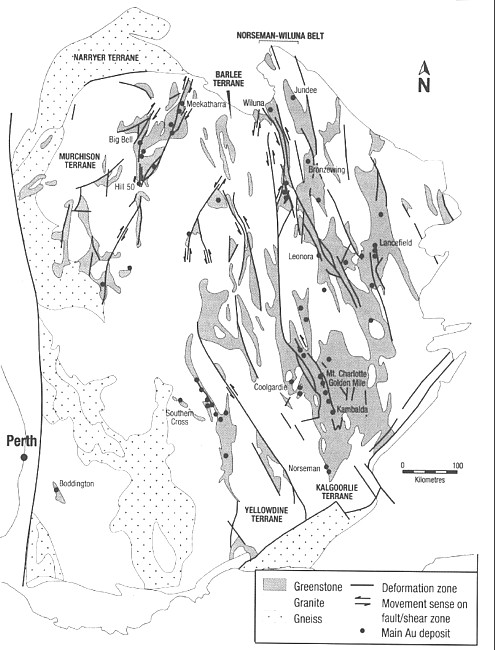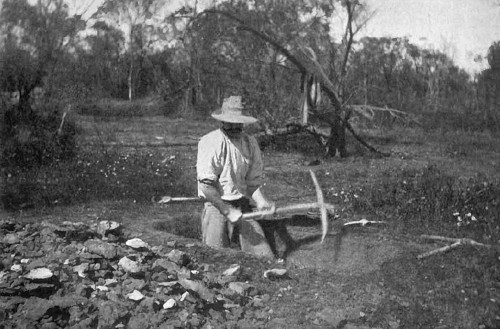In West Australia there is much evidence of that which geologists euphuistically term the Aeolian agency. The wind has been stirring and sifting the material lying loose on the surface until it has become classified to a remarkable degree. In traveling over the country, one is soon called upon to notice the broken white quartz scattered over the ground, in big patches many acres wide. These alternate with stretches, steel-gray in the morning and blue-black toward the close of day, of ironstone fragments. Leave the trail; go a short distance into the bush; and you will find the surface covered with dust in which each step leaves an evident footprint. It is the veritable dust of ages, not the earth-smoke blown from man's restless to-and-fro. The wind has sorted the quartz, the ironstone and the dust. The latter has been scattered in contemptuous carelessness all over the face of the weary desolation, but the heavy ironstone remains not far from where it was broken off the decomposing diorite until, shattered and comminuted to powder, it also is winnowed by the dust-storm. The numerous veins, large and small, traversing the country have contributed the quartz which the wind has collected, so that it sometimes covers the ground with the glittering whiteness of a snow-drift.
From these stretches of ironstone and quartz one would naturally infer the occurrence, somewhere underneath the surface, of large masses of both. Owing to the extreme slowness with which denudation progresses in this arid region, and the consequent very gradual lowering of the zone of oxidation, the rocks exhibit, above the drainage-level, a marked intensity of chemical action. The granite is kaolinized to an almost incoherent clay, and the diorite is rendered abnormally heavy in iron by the surface-concentration of decomposition-products. And, as the rock is eroded, the quartz, on account of its hardness, persists, so that a series of small stringers eventually yields an accumulation suggestive of its derivation from a large mass. It is a process of concentration which, there is reason to believe, has also affected the gold-occurrence, the upper portions of veins being enriched by the deposition of the gold left behind from lode-matter which was long ago disintegrated and removed by erosion. If we now turn to the "dry-blower" and watch him at his work we shall see the same processes utilized in the winnowing of the gold.
Dry Panning
In West Australia the absence of running water renders
unavailable the cradle and the sluice-box of ordinary placer mining, with
the result that the prospector has learnt, intuitively, to utilize the
agency which he sees incessantly at work in the nature around him. Wind
replaces water. The method is simple. Taking two pans, he places one of them
on the ground, empty, while into the other he puts a shovelful of the
"dirt," that is, the sandy detritus containing the gold. The material is
shaken up so as to bring the big lumps on top, and then, resting the pan on
one knee and holding it with his left hand he uses the right hand to skim
off the coarse particles. Then standing erect and facing at right angles to
the direction of the wind, he slowly empties the full pan into the empty one
at his feet. As the stream of dry dirt falls, the wind selects the fine and
blows it in a cloud of dust to leeward. The operation is then reversed, the
pan which has just been emptied being placed on the ground so as to receive
the contents of the other. This is repeated three or four times, according
to the degree of concentration effected. In a strong breeze one operation
may prove sufficient. To prevent the loss of the fine gold which is
sometimes carried away with the dust it is customary to spread a piece of
canvas on the ground, one end being placed under the pan and the other
extending to leeward. The next stage is to further winnow the material by
tossing it up and down in the pan; the latter is held slanting forward, and
is jerked so as to throw the dirt from the front to the back of the pan. The
light particles are separated, as chaff is driven from grain. Then, giving
the dish a vanning movement, the prospector again removes the coarser
particles that come to the surface by skimming them off with his hand. There
now remains about half a pint of material, and this is diminished by
panning, just as in water, the dry particles having a mobility permitting
this method of treatment. Finally he drops on his knee, and, holding the pan
so that it is tilted forward, he raises it up to his mouth and uses the
breath of his lungs to complete the process. The particles of gold are seen
fringing the edge of the iron sand. If the yield consists of only a few
minute particles, he puts his moist thumb on them, and so transfers them to
his pocket; but if there be any coarse pieces nuggets they are put into the
leather wallet attached to his belt. In watching a dry-blower at work, it
becomes evident that the operation, like every process of concentration when
properly conducted, consists of sizing and classification. The wind removes
the fine sand and the dust, the operator's hand skims off the larger lumps
of dirt, so that there finally remains a collection of those heavy particles
of ironstone which, as in ordinary placer-mining, accompany the gold. Owing
to the perfect dryness of the dirt and the heat imparted to the surface of
the iron pan under a tropical sun, the material behaves with much of the
mobility which it would have if water and not air were the vehicle employed.
It reminds one of the behavior of a charge in the roasting-furnace, in which
the hot air cushions each particle so as to give to the mass an apparent
fluidity.
The rapidity and completeness of the operation depend on the strength and uniformity of the wind. There is a constant light breeze on the gold-fields, even during those happy intervals when the dust-whirls have temporarily subsided; but the cloudy mornings of the wet season and the sultry days of the hottest summer months are alike unfavorable to dry-blowing, because at such times the air is dead. Many of the mining camps are situated on a slight rise of ground, overlooking those desolate sinks of salt and sand which are called "lakes;" and the difference of level is marked by a constant breeze which is a good friend to the dry-blower. In the history of ordinary alluvial mining, washing with the pan was succeeded by the use of the sluice-box and the cradle. Similarly the "dishes" of the dry-blower are replaced by machines of several types, all of which, however, are based on the idea of a shaking movement in the presence of a current of air. The simplest machine is 2 feet wide and 4 feet long. A is a hopper with a sheet-iron bottom punched with 1-inch holes, a 12-mesh screen, an 18-mesh screen, and the final product of the operation. The dry-blower empties a shovelful of dirt into the hopper, places his hands on the two sides of the machine and shakes it from side to side. There is sufficient play in the frame itself to permit a movement which causes the material to pass through the series "of screens and accumulate underneath. It is then treated by hand, as previously described. One man will put through about 5 tons of loose dirt in a working day of seven hours. Another and more elaborate contrivance consists of a series of four trays, hung on a triangular frame. The trays are 22 inches in diameter. They are comparatively flat and have screen-bottoms, through the center of which an iron rod passes to the eccentric, which receives the required movement through the lever of which is the handle. The trays are 5 inches apart and are held in place by wires. The material to be treated is placed in the uppermost tray, which is a hopper pierced with inch-holes. The final product is dry-blown by hand, as heretofore described.
In these two contrivances no attempt is made to supplement the wind by an artificial air-current. The next step is to use a bellows. When the material is placed in the hopper and the machine is set in motion, the large lumps run off over the grizzly or sizing-screen, the upper part of which is made of parallel wires, and the lower portion of 8-mesh. The finer stuff falls down into the shoots and reaches another screen, supplied also with riffles. As it descends through the screens, the blast from the bellows keeps the material in agitation, and aids the requisite separation between the particles of gold and the dust. The final product is panned by hand.
One of the most popular dry-blowing machines is that made by Steve Lorden, at Freemantle. The essential parts are a feed-hopper; sheet-iron bottom punched with inch-holes, hinged and provided with riffles which arrest the heavier particles of gold, while the coarse lumps of dirt pass out of the machine over the shoot and the fine stuff falls through into a second hopper, which has riffles and smaller perforations, repeating the process. It also has brackets for the insertion of two poles, by means of which a couple of men can carry the machine conveniently. The operator holds one handle in each hand and rocks the machine, this serving simultaneously to put the bellows, hopper and screens all into movement. The machine weighs 124 pounds and has a capacity of from 10 to 14 loads (roughly one ton each) per day. The price at Freemantle is about $80. The deposits exploited by the aid of these machines are of a generally patchy character and lie at the upper ends of the depressions formed where the surface slopes away from ridges traversed by the veins of gold-bearing quartz. The prospector has an eye for the contour of the ground, and looks for the point where the rock-surface disappears under the fragmentary overburden which he called "made ground" as distinguished from the underlying “bed-rock." In his search he is usually guided by seeing the outcrop of quartz, marking a possible source of detrital gold, and by the actual finding of specimens on the surface.
The distribution of the gold in these deposits reminds one of its position on a vanning-shovel. It may be traced up to the outcrop which yielded it, or it may be scattered in the sand for half a mile; but the rich and only workable part of the deposit will ordinarily be found at a distance of 30 or 40 feet from the reef. Underneath these patches of superficial gold-bearing detritus there are found partially consolidated accumulations, which are more extensive and, quite apart from their greater economic value, are also of superior interest, because of their better-defined geological features.
Continue on to:
The Alluvial Deposits of Western Australia, Part V
Return To:
Important Gold Mining Regions Worldwide


